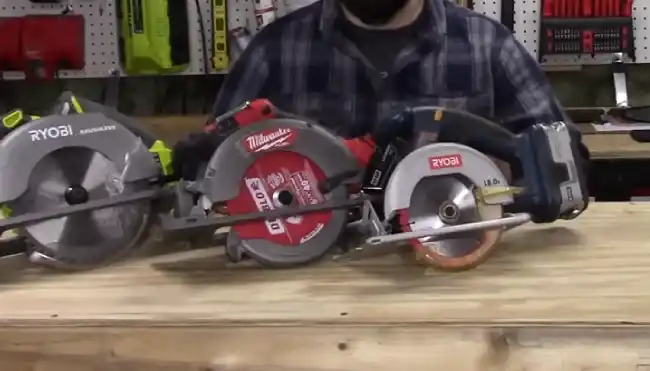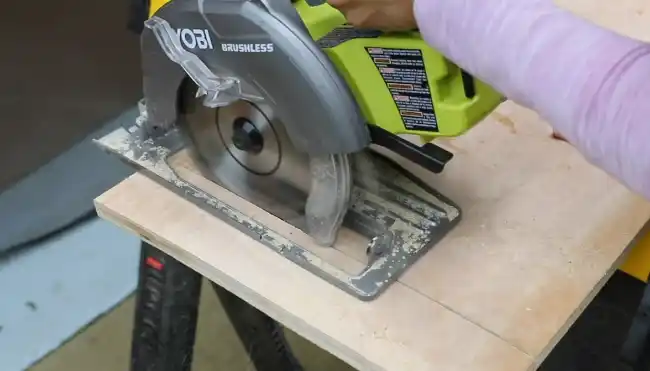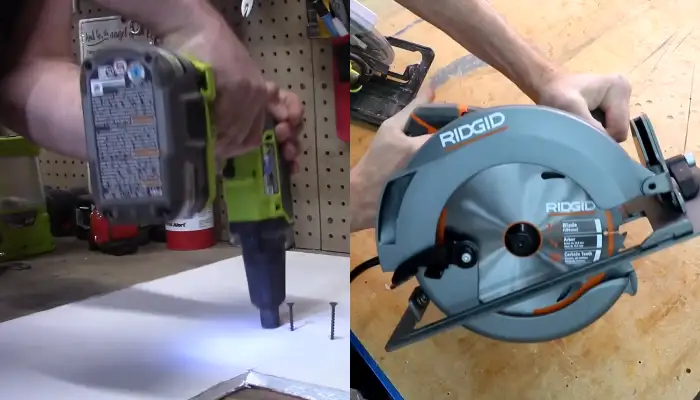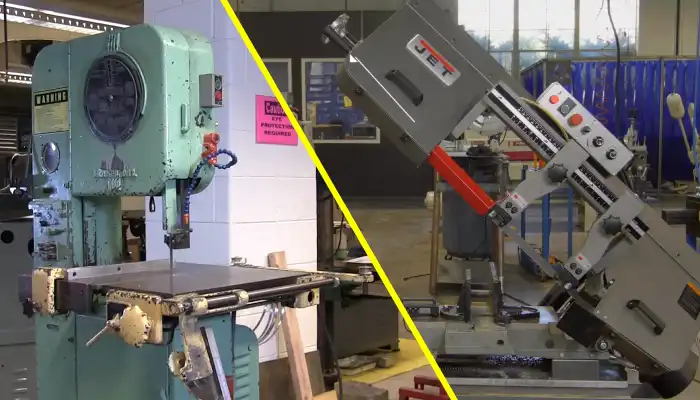Rotary Saw vs Circular Saw: 10 Differences for Carpentry
As a carpenter enthusiast, there is nothing more important than having the right tools for the job. Whether you are a beginner or an expert in carpentry, understanding the differences between a Rotary saw and a Circular saw will help ensure your work stands out.
According to my research, Rotary saws have smaller blades (2-3 inches) that move downward, providing enhanced control and accuracy, ideal for precise cutouts in thin materials.
Conversely, circular saws feature larger blades (7.25 inches) that move upward, suitable for efficient straight-line cuts in larger pieces of wood during carpentry.
Here, I will discuss the differences between these two power tools and their suitability for various carpentry jobs. From detailed work to cordless options and maintenance requirements, I’ll dive into details so you can make an informed decision.
- Tool-Free Bit Change
- Powerful 5.0 Amp Motor
- Slim and Ergonomic Design
- Dust-Sealed Switch for Durability
- Fast 30,000 RPM Cutting Speed
- Compact and Powerful Design
- Versatile Cutting Capability
- EZ-Set Depth Gauge for Precision
- Left-Sided Blade Optimization for Visibility
- Lightweight and Portable at 4.4lbs
Differences Between Rotary Saw and Circular Saw

When it comes to rotary saws and circular saws, there are some major differences that need to be taken into account. Here, I listed them out for you.
- Primary use in carpentry
- Overall size and weight
- Blade size and movement
- Ease of blade change
- Handling and operation
- Versatility in material cutting
- Intricacy of cuts
- Cutting accuracy and depth adjustment
- Safety considerations
- Cost and accessibility
No 01: Primary Use in Carpentry
As I know, rotary saws feature rotating blades that allow them to be used to cut curved shapes in plywood or drywall and openings for electrical outlets.
In contrast, with its large, toothed blade, the circular saw excels at making straight cuts in thicker, larger pieces of wood, such as framing lumber or plywood sheets. Its power and speed make it the go-to choice for quickly and efficiently cutting through these materials.
No 02: Overall Size and Weight
I prefer using the rotary saw over the circular saw due to its compact size and lightweight design. The rotary saw is designed to be small and lightweight, making it highly maneuverable and easy to handle with just one hand. This is particularly beneficial in carpentry jobs where confined spaces are common.
The compact size of the rotary saw allows for greater precision and flexibility, making it suitable for tasks that require intricate cuts.
On the other hand, the circular saw is larger and heavier, providing stability and power for cutting through larger pieces of wood efficiently. Its robustness makes it ideal for straight-line cuts in carpentry projects.
No 03: Blade Size and Movement
The rotary saw and the circular saw differ in terms of blade size and movement.
Rotary saws typically have smaller blades, measuring around 2-3 inches in diameter. These blades move downward, enhancing control and accuracy. This makes rotary saws well-suited for creating intricate patterns or precise cutouts in carpentry, especially when working with thin materials.
Conversely, circular saws feature larger blades, typically around 7.25 inches. These blades move upward, allowing them to tackle thicker pieces of wood in carpentry effortlessly. The larger blade size and upward movement of circular saws ensure efficiency and speed in tasks that require cutting through substantial materials.
No 04: Ease of Blade Change
A spindle lock button for rotary saws ensures that the shaft is securely held in place during blade changes. This feature allows for efficient and safe swapping of cutting bits, enabling carpenters to adapt swiftly to different materials and tasks.
Alternatively, as per my findings, changing blades on circular saws requires a more intricate process. These saws often involve arbor nuts and guards that demand more time and attention. While still feasible, the blade-swapping process on circular saws may require additional steps compared to rotary saws.
No 05: Handling and Operation
When working with a rotary or a circular saw for carpentry jobs, the differences in handling and operation become apparent.
A rotary saw, with its one-handed grip, offers carpenters the comfort and maneuverability necessary for intricate detailing and working in tight corners. This makes it ideal for tasks that require precision and finesse.
On the other hand, a circular saw is operated with both hands, providing a stable and controlled cutting experience. Due to their two-handed operation, circular saws are ideal for longer, straight cuts and tasks requiring precision in larger woodworking projects.
No 06: Versatility in Material Cutting

Rotary saws excel in cutting through a wide range of materials, including thin substances like drywall and plywood and tougher materials like concrete and stone. This adaptability makes rotary saws a go-to tool for carpenters working on diverse projects.
Conversely, circular saws, while still versatile with the appropriate blades, are primarily designed for cutting large pieces of wood in straight lines. Their proficiency lies in traditional woodworking applications.
I think, for handling various materials, the rotary saw outshines the circular saw.
No 07: Intricacy of Cuts
Due to its smaller, more maneuverable design, you can frequently rely on the rotary saw for carpentry jobs that require intricate cuts. When creating decorative patterns or crafting custom shapes, the rotary saw provides the precision and control needed for intricate cuts.
Its compact size allows for more intricate movements, making navigating tight corners and curves easier. Additionally, the rotary saw’s ability to rotate the cutting blade allows greater versatility in achieving complex cuts.
Alternatively, while capable of precision cuts, the circular saw may be better suited for straightforward, long straight lines. I believe due to the size and weight of a circular saw, it may be more challenging to control when making intricate cuts.
Regarding intricate cuts, the rotary saw’s design and maneuverability make it the preferred tool for carpentry jobs that demand a high level of detail.
No 08: Cutting Accuracy and Depth Adjustment
Rotary saws come equipped with a depth guide and adjustment screw, allowing carpenters to set the desired cutting depth easily. This feature is particularly important when working on projects that require accuracy in different materials.
In contrast, circular saws can be adjusted for depth by manipulating their height and depth settings. While the process may be slightly different, the result is the same. The ability to customize cutting depths based on the project’s specific requirements.
No 09: Safety Considerations
According to my research, rotary saws often come equipped with a hand strap that provides added control and stability during operation. Additionally, they feature a locking lever that ensures the cutting guide remains securely in place.
Conversely, circular saws prioritize safety with features such as a trigger switch and guards. The trigger switch allows for easy and safe activation of the saw, while the guards minimize the risk of accidents by providing a physical barrier between the blade and the user.
No 10: Cost and Accessibility
Often, the cost and accessibility of rotary and circular saws play a significant role in carpenters’ decision-making processes.
Regarding cost, rotary saws tend to be more budget-friendly compared to circular saws. This is primarily because rotary saws are smaller and more specialized, making them a more affordable option for carpenters looking to enhance their toolkits without breaking the bank.
On the other hand, circular saws are generally more expensive due to their larger size and versatility.
Accessibility is another factor to consider, as the availability of both types of saws may vary depending on the location and supplier.
Comparison Table Between Rotary Saw and Circular Saw
| Feature | Rotary Saw | Circular Saw |
| Primary Use in Carpentry | Cutting curved shapes and intricate patterns | Making straight cuts in thicker, larger materials |
| Overall Size and Weight | Compact and lightweight for maneuverability | Larger and heavier, providing stability |
| Blade Size and Movement | Smaller blades (2-3 inches) moving downward | Larger blades (7.25 inches) moving upward |
| Ease of Blade Change | Spindle lock button for efficient and safe changes | More intricate process with arbor nuts and guards |
| Handling and Operation | One-handed grip for comfort and maneuverability | Two-handed operation for stability and control |
| Versatility in Material Cutting | Cuts a wide range of materials, including thin and tough substances | Primarily designed for cutting large pieces of wood |
| Intricacy of Cuts | Ideal for intricate detailing and tight corners | Better suited for straightforward, long, straight lines |
| Cutting Accuracy and Depth Adjustment | Depth guide and adjustment screw for precise cuts | Adjustable depth through height and depth settings |
| Safety Considerations | Hand strap for added control and stability | Trigger switch and guards for safety |
Can circular saws be used for detailed carpentry work?

I’ve found that circular saws can be effectively utilized for detailed carpentry work using a guide or jig. While rotary saws are typically preferred for intricate detailing, circular saws can still achieve precision cuts when used with the right tools.
I believe that with proper setup and technique, carpenters can achieve excellent results with a circular saw in detailed carpentry projects.
Do rotary and circular saws come with cordless options?
Cordless models offer increased mobility and flexibility, allowing you to move freely without the constraints of a power cord. Both rotary and circular saws come with cord or cordless options that are powered by rechargeable batteries.
These batteries provide sufficient power to tackle most carpentry jobs, making them suitable for job sites with limited or unavailable power sources.
Cordless rotary and circular saws are designed to be lightweight and compact, making them easier to handle and maneuver. They also offer the convenience of quick and easy setup without the need for extension cords or power outlets.
Do circular and rotary saws require special maintenance?
Special maintenance is necessary for circular and rotary saws to ensure optimal performance and longevity. Although rotary saws may require less maintenance due to their smaller and simpler design, they should be regularly inspected, lubricated, and have their blades sharpened or replaced as needed.
Regular inspection is crucial to identify any signs of wear or damage, such as loose screws or misaligned components. Lubrication helps to reduce friction and prevent overheating, ensuring smooth operation.
Blade sharpening or replacement is essential to maintain cutting efficiency and prevent the saw from binding or producing rough cuts.
Rotary and Circular Saws: Dynamic Duo of Carpentry

As you can see, in the ever-evolving landscape of carpentry, the rotary saw and circular saw emerge as stalwart companions, each excelling in its domain.
The distinctions in size, blade movement, handling, and material versatility play pivotal roles in determining the most suitable tool for the task at hand. Whether carving intricate details or cutting thick materials, carpenters must weigh the advantages and disadvantages of circular and rotary saws.
While circular saws aren’t typically used for detailed carpentry work, rotary saws excel in this area. Additionally, both types of saws now offer cordless options for increased convenience. Regarding maintenance, both rotary and circular saws require special care to ensure optimal performance and longevity.
- Powerful 27,000 RPM Performance
- Versatile 1/8″ and 1/4″ Bit Compatibility
- Effortless Bit Changes with Spindle Lock
- Maximum Comfort with Durable Overmold Grip
- Portable and Cordless Convenience
- Powerful 15-Amp Motor
- Single Beam Laser Guide
- 51° Bevel Capacity
- Dust Blower for Visibility
- Spindle Lock for Easy Changes
Last update on 2026-01-08 / Affiliate links / Images from Amazon Product Advertising API











